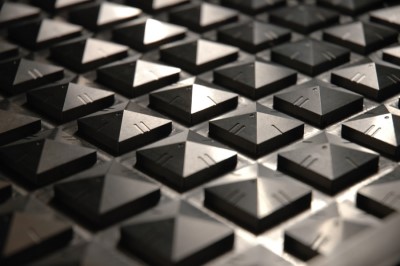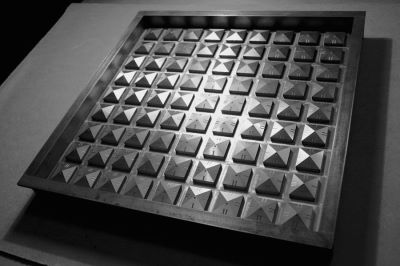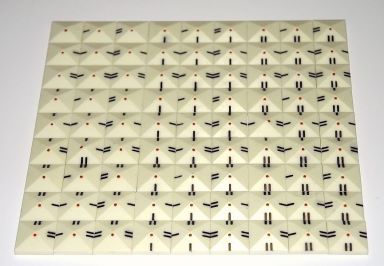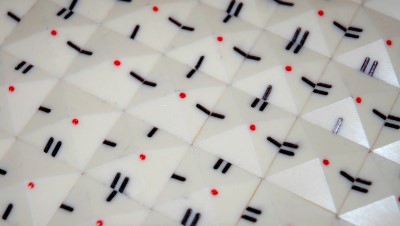The History of Legion
Legion is invented
Legion was invented by Tristram Bishop in 1998. The idea of a matching tile game came to him when he had a bad fever and a temperature of 104 degrees. The problem was to find a way to produce a set of four-sided tiles that could be matched together in lines, either horizontally or vertically. The initial concept and the first design came in a flash a few weeks later. "It was an epiphany", says Tristram. "The whole concept came at once - the rationale for the 'set' of unique tiles, how it looked, the game design, everything."
The mathematical property of Legion also meant that there had to be 81 tiles. 81 is a great number as it is a square of also meant that Legion could have a square 9 by 9 board with 81 spaces, the same as the number of tiles. This aspect of the game is one of the main reasons that Legion is so much fun to play.
First PC game produced
The obvious next step was to produce the game so that it could be played. The first set was made of cardboard tiles played on board printed on a piece of paper. The game was greeted with enthusiasm and the next step was to produce a computer version. The first two-player game was developed by Bob Sutton, using Flash version 4. This release had one major drawback – two people would have to sit together at a single computer.
First game sets produced
The next step was to produce a real version of the set. It made sense that the dashes on the tiles were either inset or raised, so that people with impaired sight could also play. In the end, the dashes were inset. Making a set involved commissioning a local engineering firm, Accura Tool Company, to construct a 'former' from which rubber composite molds could be made. Tom Hookey, Accura's MD made the former out of a single piece of stainless steel and a most beautiful thing it is.
 |
 |
The stainless steel 'former' is used for making silicon-rubber molds. Each mold can be used for producing 5 to10 sets of Legion tiles |
|
In the first production run, around 20 sets were produced. Making the sets was a messy and time-consuming process, as the tiles were made out of a fast-drying epoxy composite. Sometimes, bubbles would be trapped and make some of the tiles unusable. In addition, the dashes on each piece had to be coloured by hand. Also, it took around half-an-hour to clean the mold so that it could be reused. In all, it was taking around three hours to produce a single set!
 |
 |
The Legion game sets are made from hard-setting epoxy resin. The stripes and dots are hand-coloured. |
|
But is Legion really destined to be a computer game?
It soon became clear that some people had a problem calculating their own scores. The maths involved, simple multiplication and a bit of adding meant that most would get the hang of it, but it did take getting used to. This was a hurdle that new players had to jump before they could play the game.
At this time, two separate investors expressed an interest in backing Legion and going into commercial production with the game sets. In the end, neither of these deals was completed, mostly due to Tristram's reticence to remodel the tiles, which was a pre-requisite from the investors. The pyramidal shape of the tiles made automated printing very difficult indeed. Sticking stoically with the original design plans and rules, he then went on to try and get a developer interested in producing a two-player computer version that could be played over on the web, by two remote players logging in from different locations. This would be accessed from the playlegion.com website and, potentially through the. then new, social networking sites such as Facebook.
A big development project
in 2008 Bob Sutton, who had produced the first game, started development of the internet version It proved to be too big a project, however, for him to produce on spec. Some months later Gareth Hallberg, another expert developer and friend, decided to have a crack. The aim of this development was to build a partially working demo to show to the potential investor (the third) and to secure development funding.
Bad news
But there was bad news. This potential investor was in the commercial property business. He had been very interested in producing game sets, but really had no interest at all in a web version, as this was just not his bag. He was also in the process of selling up his UK portfolio and moving to Dubai, tired of paying 40% Capital Gains Tax. Without funding, the project was too large for Gareth to complete by himself. Legion had missed the boat again.
But then…
The iPad came out. Gareth, having sailed through a Masters degree and having started his Doctorate, was interested in building Legion using Cocos 2d, the iPad development platform. Although he had developed games apps in the past in a variety of programming languages, he had not yet completed a full-scale project using Cocos 2d, the iPad app programming language.
Hooray!!
After a few months and with great support from Chris Hipgrave, Gareth's partner in development company Horseshoeshape.co.uk, the iPad Legion app was produced. At the beginning, it still used the original graphic and piece design. It was now finally time to call in expert help with the graphics, and Gareth asked his friend and associate Andrew Gibbs from 'Public Works Office' to take a look.
Andrew came up with a great concept, which was to use a retro, 1950's style for the graphics. The look that he has produced is quite remarkable and totally original. The retro style fits in extremely well with the traditional feel of the game-play.
Legion is now available on the iPad, iPhone and iPad from the Apple App Store. Hooray!!
